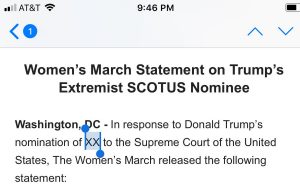Judge Kavanaugh and the Internet
Many technology beat bloggers and journalists have weighed in on the impact that Judge Brett Kavanaugh will have on the Internet if confirmed for a seat on the Supreme Court. His record isn’t very broad on the subject, so the coverage tends to focus on two cases.
In one case, he joined a unanimous DC Circuit opinion denying an emergency petition for rehearing en banc of an order refusing to grant an injunction against the NSA’s telephone metadata collection program. (This program was recently constrained by the Supreme Court to limit warrantless collection of locations to recent data.)
Kavanaugh took the unusual step of writing an opinion on his denial, where other judges simply refused the request without stating their reasons. His opinion simply cites the clear (at the time) precedent that data collection from third parties is reasonable under the Fourth Amendment. This was concerning to privacy hawks, but in step with his colleagues.
The Infamous Title II Case
Bloggers are paying a lot more attention to Kavanaugh’s dissent in the DC Circuit’s denial of an en banc review of the decision by Judges Tatel and Srinivasan giving a green light to the FCC’s 2015 Title II order, AKA “net neutrality order”. This is the order repealed by the FCC’s more recent Restoring Internet Freedom order, restoring the Title I (AKA “enhanced service”) classification of Internet service providers that was the law from the beginning of ISPs in 1989 until 2015. (I filed an amicus brief in hopes of getting it repealed.)
Plaintiff US Telecom sought an en banc review of the two judge decision, but their request was rejected by the same two judges (fancy that!) along with six others. Their grounds were largely that the FCC was likely to vacate the Title II order anyway, so the appeal was a waste of time.
Judges Rogers and Kavanaugh, not persuaded by the majority’s expediency-based reasoning, invoked the Supreme Court’s “major questions” doctrine; Kavanaugh also added a First Amendment rationale of his own. The bloggers have generally refused to mention the major questions doctrine, echoing common snark around the free speech question and the NSA program.
Wheeler’s Order Wasn’t all that Powerful
Former FCC Chairman Tom Wheeler’s Title II order didn’t do much for net neutrality after all. The discussion of the First Amendment rights of ISPs turns out to be fairly nuanced, because they do have editorial rights over their networks should they choose to use them.
Wheeler’s order only applies to: “A mass-market retail service by wire or radio that provides the capability to transmit data to and receive data from all or substantially all Internet endpoints…” [Title II order, para 25]. Hence, an ISP who makes no such promise has editorial discretion as to which endpoints it chooses to block or throttle.
Fans of the Title II order say that ISPs relinquish their First Amendment rights simply by claiming to provide service to the whole Internet, limited only by public safety or network management considerations. This seems like an arguable point to me, and it appears that it does to Judge Kavanaugh as well.
So There’s Really Nothing Special About the Internet
It also appears that the heart of Wheeler’s concept of net neutrality is simply truth in advertising: if you claim to bring me the whole Internet, you better do that. This argument in particular is something the FTC can enforce without any net neutrality regulations.
There is an element of freedom on the part of ISPs with respect to how they bring the whole Internet to me, of course. The how is more essential to the concept of net neutrality’s constraints on throttling, differentiation, and third party pricing. But even here, the truth in advertising issue would seem to play a role.
Not being a lawyer, I’ve never paid much attention to the First Amendment side of net neutrality; my concerns are technical. But it has certainly been part of the debate by others all along. The bloggers aren’t in such a great position to sneer at legal reasoning on this very complex topic.
The Major Question is the Major Question (Doctrine)
It’s a lot harder for bloggers to address the major questions doctrine than to echo widely repeated free speech claims; the only one who has come close to it is TechCrunch’s Devin Coldeway. He criticizes Kavanaugh’s major questions concern by copy-pasting some text from Judge Srinivasan’s denial of the US Telecom en banc review petition:
We have no need in this case to resolve the existence or precise contours of the major rules (or major questions) doctrine described by our colleagues. Assuming the existence of the doctrine as they have expounded it, and assuming further that the rule in this case qualifies as a major one so as to bring the doctrine into play, the question posed by the doctrine is whether the FCC has clear congressional authorization to issue the rule. The answer is yes. Indeed, we know Congress vested the agency with authority to impose obligations like the ones instituted by the Order because the Supreme Court has specifically told us so.
Leaving aside the question of the legitimacy of Srinivasan ruling in favor of his own prior ruling, his reasoning here strikes me as dubious. Let’s see if Srinivasan’s argument hangs together.
Legal Sleight of Hand
Srinivasan begins his discussion of major questions by invoking the Brand X decision on Internet Service over cable modem. This opinion said that Internet Service provided over cable modem was reasonably classified by the FCC as an information service (Title I) rather than a Title II telecommunication service because the Communications Act is silent on Internet Service over cable modem.
It also ruled that the Ninth Circuit had erred in classifying Internet Service over cable modem as a Title II service by misreading precedents on Chevron deference:
Nothing in Portland held that the Communications Act unambiguously required treating cable Internet providers as telecommunications carriers. Instead, the court noted that it was “not presented with a case involving potential deference to an administrative agency’s statutory construction pursuant to the Chevron doctrine,” id., at 876; and the court invoked no other rule of construction (such as the rule of lenity) requiring it to conclude that the statute was unambiguous to reach its judgment. Before a judicial construction of a statute, whether contained in a precedent or not, may trump an agency’s, the court must hold that the statute unambiguously requires the court’s construction. Portland did not do so.
Hence, the FCC was free to apply its own reasoning to the question of ISPs operating over cable modem (or DSL) over and over again. The case did not touch on major questions, perhaps most strongly because ISPs had long been understood to provide information services. This is quite obviously the case for dial-up where there was 15 years of precedent before Brand X.
But the clever part of Srinivasan’s reasoning is his pivot from dealing with ISPs operating over cable modem to the status of naked cable modem service. He does this on a page break in his opinion.
Srinivasan’s Pivot
At the end of page 3, Srinivasan discusses Internet Service:
Brand X involved the provision of broadband internet access via cable systems. At the time of the decision, cable broadband was one of two types of broadband service available to customers, the other being DSL (digital subscriber line). See id. at 975.
But at the beginning of page 4, he shifts to naked cable modem with no Internet:
The FCC had applied a different form of regulatory treatment to cable broadband service than to DSL service. The agency had classified DSL as a “telecommunications service” for purposes of the Communications Act. See id. at 975, 1000…That classification carries significant statutory consequences. The Act requires treating telecommunications providers as common carriers presumptively subject to the substantial regulatory obligations attending that status. See id.at 975-76. Common carriers, for instance, generally must afford neutral, nondiscriminatory access to their services, and must avoid unjust and unreasonable practices in that connection. See id. at 975-76, 1000.
Whereas the FCC had classified DSL broadband as a telecommunications service, the agency had instead elected to classify cable broadband as an “information service,” the other of the two classifications available to the agency under the statute.
This isn’t completely accurate. The FCC had applied Title II to naked DSL service, which required phone companies to sell it to ISPs on wholesale basis. DSL actually pre-dated broadband Internet service.
Cable companies did not offer naked cable modem service for sale, and in fact invented it solely for the purpose of enabling broadband Internet service. Hence there was not only no technically feasible way for cable to share its wires with retail ISPs, there was no history of non-ISP uses of cable modem.
So the regulatory status of cable modem was not a major question in 2005 and the Court had to reason to pretend otherwise. The Supreme Court took the easy way out and applied the rich body of Chevron law to the matter and washed its hands of it.
Srinivasan Appears to Have Misread the Law
If Srinivasan misread the Court’s reasoning in the Brand X case, it wouldn’t be the first time an appellate judge botched the law; Brand X deals with a misreading of the Portland case law by the Ninth Circuit, after all.
Coldeway continues down the path Srinivasan blazed by confusing ISP service with raw broadband. I suspect neither of them would fail to recognize this distinction if it were pointed out to them as it appears that they were simply a little hasty in confusing discrete services that are commonly combined.
So the major question is whether a service that combines information processing with telecommunications can be stuffed into the highly burdensome basket labeled Title II. It’s more straightforward to recognize that a broadband ISP is more ISP than broadband link. The Internet is, after all, technology neutral.
Judge Kavanaugh’s Dissent
Judge Kavanaugh addresses this question head on:
The problem for the FCC is that Congress has not clearly authorized the FCC to classify Internet service as a telecommunications service and impose common-carrier obligations on Internet service providers. Indeed, not even the FCC claims that Internet service is clearly a telecommunications service under the statute. On the contrary, the FCC concedes that “the Communications Act did not clearly resolve the question of how broadband should be classified.” FCC Opposition Br. 9. Therefore, by the FCC’s own admission, Congress has not clearly authorized the FCC to subject Internet service providers to the range of burdensome common-carrier regulations associated with telecommunications services.
Under the major rules doctrine, that is the end of the game for the net neutrality rule: Congress must clearly authorize an agency to issue a major rule. And Congress has not done so here, as even the FCC admits.
Changing ISPs from their historic status to Title II is a move the FCC can’t make without Congressional authorization. This is especially true given that the 1996 Telecommunications Act clearly declares ISPs to be information services. There is no clue in the ’96 Act that substituting dial-up for broadband changes the nature of ISP service.
This is why all but one of Judge Kavanaugh’s critics avoids this question. Kavanaugh will make a fine Supreme Court justice because he’s careful in his reasoning. We can’t say that for most of his critics.
Bonus Update
Speaking of careless criticism, one of Kavanaugh’s critics issued a clearly pre-written press release denouncing the nomination.
Very thoughtful. Hashtag #StopXX is now trending.




